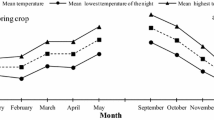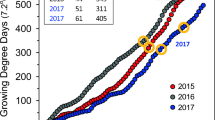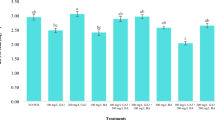Summary
Of five growth regulators applied to seed tubers in January when sprout growth had just started, only gibberellic acid (GA) materially affected apical dominance or subsequent development. GA increased the number of sprouts by one third and induced the production of many stolon-like branches. After planting, the number of main stems was greater with GA, as was the number of branch stems and tubers; total yield was not affected, but the yield of seed-sized tubers was increased by up to 70%.
Zusammenfassung
Frühere Arbeiten über den Einfluss der Keimbildung zu verschiedenen Zeitpunkten deuteten an, dass eine Kombination von früher Keimildung und Verminderung der apikalen Dominanz notwendig ist, um die Knollenzahl pro Pflanzstelle zu erhöhen. Es wurde ein Versuch gemacht, die apikale Dominanz zu verringern, indem Pflanzkartoffeln im Januar unmittelbar nach Beginn des Keimwachstums mit fünf Wachstumsregulatoren in je drei Konzentrationen behandelt wurden. Die Einzelheiten der Verfahren sind im Abschnitt ‘Material and Methods’ angegeben; ihre Wirkung auf das Keim- und Stengelwachstum sowie auf die Knollenzahl und den Ertrag sind in Tabelle 1 aufgeführt. Nur die Gibberellinsäure (GA) beeinflusste die apikale Dominanz oder das nachfolgende Wachstum wesentlich. GA erhöhte die Anzahl der Keime und der Haupttriebe um 1/3, ebenso erhöhte sie stark die Anzahl der stolonenartigen Seitentreibe an den Keimen; einige der letzteren entwickleten sich nach dem Auspflanzen wahrscheinlich in Seitenstengel. Zweimalige Behandlung der Knollen mit Konzentrationen von 50und 100 ppm verursachten ein früheres Auflaufen und eine frühere Knollenbildung; dies im Gegensatz zu Bruinsma et al. (1967) und Lovell und Booth (1967), die fanden, dass GA den Beginn der Knollenbildung verzögere. Der frühere Beginn der Knollenbildung wurde durch das frühere Auflaufen und das fortgeschrittene Stolonen-wachstum zur Zeit des Auspflanzens ermöglicht. Es waren kein signifikanten Einfluss von GA auf den Krautertrag bei irgendeiner der drei Musterentnahmen (Abb. 1) und keine ungünstigen Symptome, wie z.B. die von andern Forschern beobachtete Chlorose, festzustellen. Unbehandeltes Pflanzgut und solches, das zweimal mit einer GA-Lösung von 5, 50 und 100 ppm behandelt wurde, ergaben 10.8, 13.7, 17.0 bzw. 19.8 Knollen pro Staude und einen Pflanzknollenertrag von 12.4, 15.6, 17.6 bzw. 21.2 Tonnen/ha (Tabelle 2). Diese Unterschiede in der Knollenanzahl waren zur Zeit des Beginns der Knollenbildung schon klar ersichtlich (Abb. 1).
Die in der Literatur berichtete Unterschiedlchkeit in der Reaktion der Gibberellinsäure wird im Zusammenhang mit der Anwendungs-methode und dem Zusatand der Pflanzknolle zur Zeit der Behandlung besprochen. Man kommt zum Schluss, dass weitere Arbeiten über Faktoren, die die Aufnahme von GA durch die Knollen beeinflussen, notwendig sind, bevor die Verwendung für die Produktion von Pflanzkartoffeln für den Handel empfohlen werden kann.
Résumé
Une étude précédente sur l'effet des variations dans la durée de la germination a suggéré l'hypothèse qu'une combinaison de la germination précoce et de la réduction de la dominance apicale était nécessaire pour accroître le nombre de tubercules par touffe. On a réalisé un essai de réduction de la dominance apicale par application de cinq régulateurs de croissance, à 3 concentrations chacun, à des plants de pomme de terre, en janvier, au moment du départ de la germination. Les détails des traitements sont donnés dans le paragraphe ‘Materials and methods’ et leurs effets sur la croissance du germe et de la tige, de même que sur le nombre de tubercules et la production figurent au tableau 1. Seul l'acide gibberellique (GA) influence réellement la dominance apicale ou la croissance subséquente. GA augmente de 1/3 le nombre de germes et de tiges principales et augmente également le nombre de ramifications semblables à un stolon sur les germes; plusieurs de ces derniers se développent probablement en branches de tiges après la plantation. GA pulvérisé deux fois sur les tubercules aux concentrations de 50 et 100 ppm a donné une levée plus précoce, de même qu'une initiation plus précoce des tubercules, contrairement à Bruinsma et d'autres (1967), Lovell et Booth (1967) qui trouvaient que GA retardait celle-ci. Il est possible que l'initiation plus précoce précoce soit due à une levée plus rapide et à une croissance plus avancée de stolons au moment de la plantation. Il ne se révèle aucun effet significatif de GA sur le développement foliaire à aucun des trois arrachages d'échantillons (Fig. 1) et aucun symptôme nuisible, telle la chlorose signalée par certains chercheurs, n'a été observée. Les plants non traités et ceux traités deux fois avec des solutions de GA de 5, 50 et 100 ppm donnaient 10,8, 13,7, 17 et 19,8 tubercules par touffe, et les productions de plants étaient de 12,4, 15,6, 17,6 et 21,2 tonnes/ha respectivement (Tableau 2). Ces différences dans les nombres de tubercules apparaissent clairement au moment de l'initiation des tubercules (Fig. 1).
L'auteur discute des variations dans la réaction à l'acide gibberellique rapportées dans la littérature en fonction de la méthode d'application et de l'état du plant au moment du traitement; il conclut qu'une recherche ultérieure sur les facteurs qui affectent l'absorption de GA par les tubercules est nécessaire avant que l'on puisse recommander son utilisation dans la production commerciale de plants.
Similar content being viewed by others
References
Bartlett, M. S., 1937. Some examples of statistical methods of research in agriculture and applied biology.Suppl. Jl. R. statist. Soc. 4: 137–183.
Bleasdale, J. K. A., 1965. Relationships between set characters and yield in maincrop potatoes.J. agric. Sci. 64: 361–366.
Bruinsma, J., Sinnema, A., Bakker, D. & Swart, J., 1967. The use of gibberellic acid and N-dimethylamino succinamic acid (B9) in the testing of seed potatoes for virus infection.Eur. Potato J. 10: 136–151.
Gifford, R. M. & Moorby, J., 1967. The effect of CCC on the initiation of potato tubers.Eur. Potato J. 10: 235–238.
Goodwin, P. B., 1963. Mechanism and significance of apical dominance in the potato tuber.Proc. 10th Easter School agric. Sci. Univ. Nott.: 63–71.
Goodwin, P. B., Brown, A., Lennard, J. H. & Milthorpe, F. L., 1969. Effect of centre of production, maturity and storage treatment of seed tubers on the growth of early potatoes. II Field growth.J. agric. Sci. 73: 167–176.
Gowing, D. P. & Leeper, R. W., 1955. Induction of flowering in pineapple by Beta-Hydroxyethyl-hydrazine.Science 122: 1267.
Harmey, M. A., Crowley, M. P. & Clinch, P. E. M., 1966. The effect of growth regulators on tuberisation of cultured stem pieces ofSolamum tuberosum.Eur. Potato J. 9: 146–151.
Hiele, F. J. H. van, 1961. Unsprouted tubers with gibberellic acid.Eur. Potato J. 4: 26–39.
Humphries, E. C. & Dyson, P. W., 1967. Effect of a growth inhibitor, N-dimethylaminosuccinamic acid (B9) on potato plants in the field.Eur. Potato J. 10: 116–126.
Keller, E. R. von, 1964. Über die Auswirkungen der Behandlung vorgekeimter Kartoffelknollen mit Gibberellinsäure.Schweiz. Jander Forsch.: 3, 59–66.
Lindblom, H., 1967. Gibberellinbehandeling av utsädespotatis.Landtmannen 78 (9): 25–6.
Lovell, P. H. & Booth, A., 1967. Effects of gibberellic acid on growth, tuber formation and carbohydrate distribution inSolanum tuberosum.New Phytol. 66: 525–537.
Nijdam, F. E., 1954. Hoe ontwikkelt zich een stolone-achtige zijspruit van een aardappellichtkiem na het poten?Landbouwk. Tijdschr. 66: 701.
Reestman, A. J. & Wit, C. T. de 1959. Yield and size distribution of potatoes as influenced by seed rate.Neth. J. agric. Sci. 7: 257–68.
Slomnycki, I. & Rylski, I., 1964. Effect of cutting and gibberellin treatment on autumn grown seed potatoes for spring planting.Eur. Potato J. 7: 184–192.
Smelzer, G. G. & Mackay, D. C., 1963. The influence of gibberellic acid seed treatment and seed spacing on yield and tuber size of potatoes.Am. Potato J. 40: 377–380.
Thomas, W. L. & Eyre, P. W., 1951. Early potatoes. Faber & Faber, London.
Timm, H., Rapport, L., Primer, P. & Smith, O. E., 1960. Sprouting, plant growth and tuber production as affected by chemical treatment of white potato seed pieces II Effect of temperature and time of treatment with gibberellic acid.Am. Potato J. 37: 357–365.
Timm, H., Rappaport, L., Bishop, J. C. & Hoyle, B. J., 1962. Sprouting, plant growth and tuber production as affected by chemical treatment of white potato seed pieces IV Responses of dormant and sprouted seed potatoes to gibberellic acid.Am. Potato J. 39: 107–115.
Toosey, R. D., 1963. The influence of sprout development at planting on subsequent growth and yield.Proc. 10th Easter School agric. Sci. Univ. Nott.: 79–95.
Verma, S. C., 1966. Induction of stolons and tubers by the leaves of the potato.Eur. Potato J. 9: 259–60.
Author information
Authors and Affiliations
Rights and permissions
About this article
Cite this article
Holmes, J.C., Lang, R.W. & Singh, A.K. The effect of five growth regulators on apical dominance in potato seed tubers and on subsequent tuber production. Potato Res 13, 342–352 (1970). https://doi.org/10.1007/BF02358279
Accepted:
Issue Date:
DOI: https://doi.org/10.1007/BF02358279




